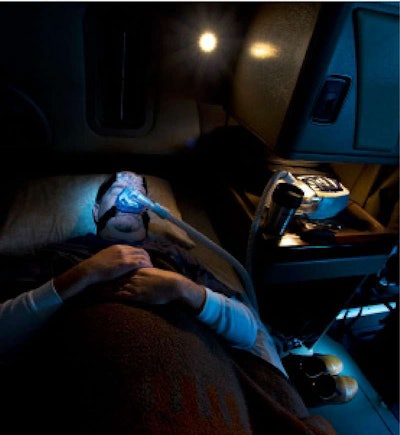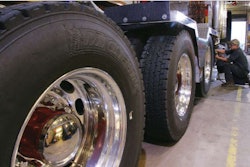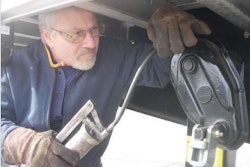 The Federal Motor Carrier Safety Administration is expected soon to issue guidelines and later initiate rulemaking that would significantly raise the bar on screening and treatment for obstructive sleep apnea and other health conditions believed to affect driver safety.
The Federal Motor Carrier Safety Administration is expected soon to issue guidelines and later initiate rulemaking that would significantly raise the bar on screening and treatment for obstructive sleep apnea and other health conditions believed to affect driver safety.Don’t be caught napping when the feds finalize stringent health regs for sleep apnea and other disorders, many of them common among truckers. Your CDL could hang in the balance.
The Federal Motor Carrier Safety Administration is expected soon to issue guidelines and later initiate rulemaking that would significantly raise the bar on screening and treatment for obstructive sleep apnea and other health conditions believed to affect driver safety.
Regulation of obstructive sleep apnea, which prevents sleepers from getting enough oxygen and rest, has become an especially contentious issue for FMCSA.
Some drivers worry that the agency will place too much emphasis on screening by single factors, such as obesity or neck size, or that mandated testing will be too costly to drivers in terms of money or downtime.
An estimated 28 percent of drivers suffer from mild to severe sleep apnea, but less than half of those with the disorder are being treated for it, experts say. Nearly 42 percent of drivers are overweight and considered prone to having the disorder.
 Pulmonary Precision Diagnostics screens, tests and monitors sleep apnea for Schneider National, Swift and W.O. Wolding in sleep labs such as this one.
Pulmonary Precision Diagnostics screens, tests and monitors sleep apnea for Schneider National, Swift and W.O. Wolding in sleep labs such as this one.Fleet safety directors and health specialists say that stricter oversight and required guidelines for screening, diagnosis, testing and monitoring of sleep apnea can’t come soon enough. Some large carriers have been working with specialists to develop their own testing and treatment programs.
Don Lacy, Prime’s safety director, says his company started screening for the condition in 2001 to help at-risk drivers reduce daytime drowsiness. “It’s rampant,” says Lacy, adding that micro-naps cause many truck-related accidents. “People can suffer from obstructive sleep apnea and not know they have it.”
Currently, the medical certification required for commercial driver license holders includes only one question regarding sleep apnea. Examiners are not required to screen for the condition if drivers respond that they are symptom-free.
Under current CDL restrictions, drivers with moderate to severe sleep apnea that interferes with safe driving can be disqualified if a state-licensed medical examiner determines they should not drive. No medicines can treat the disorder, but devices known as continuous positive airway pressure (CPAP) or auto-titrating positive airway pressure (APAP) machines open the airways with use of a face mask, allowing the user to get sound sleep. Many drivers are treated for sleep apnea with such machines and maintain their CDLs successfully.
Progress on regulating the condition has been complicated because not all parties agree on the relationship between sleep apnea and safety. FMCSA wants to verify that sleep apnea affects trucking safety before announcing a notice of proposed rulemaking and getting public comments, says FMCSA spokesman Duane DeBruyne. It may be as long as two years before a formal rulemaking process begins, says Mary Gunnels of the FMCSA’s Office of Medical Programs.
Knowing the factors that put drivers at risk for sleep apnea isn’t enough, explains Dr. Ellison Wittels, a CDL medical examiner, an FMCSA consultant for more than 20 years and a founding member of FMCSA’s Medical Review Board.
“What we don’t know is which drivers with sleep apnea will crash. You have to look at the impact of all the negative risk factors,” says Wittels, a senior physician at Concentra Medical Centers in Houston. “It’s pretty hard to come out against safe driving, but if you are too restrictive, you drive drivers underground. You have to be reasonable.”
Wittels says a push is on externally and from within the agency to make a ruling on sleep apnea. He says that the FMCSA can and probably will issue guidelines first because they can be adjusted more quickly than the rulemaking process, which can take years.
The National Transportation Safety Board is one of the parties alleging a clear connection between driver sleep apnea and safety. Last October the agency urged FMCSA to establish tighter regulations over the sleep disorder. In response to such concerns, the American Sleep Apnea Association, the American Trucking Associations and the FMCSA will sponsor a national conference in May about sleep apnea’s effect on truckers.
 A doctor and technician with Sleep Pointe demonstrate procedures for sleep apnea tests at Prime Inc.’s sleep lab facility at its Springfield, Mo., headquarters.
A doctor and technician with Sleep Pointe demonstrate procedures for sleep apnea tests at Prime Inc.’s sleep lab facility at its Springfield, Mo., headquarters.“As these guys get older, they get more illnesses,” Wittels says. The daily stress of negotiating traffic, sitting still for long periods, cigarette smoking and overeating have contributed to a higher rate of sleep apnea and obesity among truckers than in the general population. Also, the driver work force, like the entire work force, is growing older, and age is another factor associated with sleep apnea.
An expert panel recommended to the Medical Review Board in 2008 that drivers should be off the road up to a week to be tested and set up for treatment. Dr. Allan Pack, a member of the panel and a sleep specialist at the University of Pennsylvania, said that the recommendation for a week was made to allow truckers to have enough time to get to a lab to be tested and be set up for treatment. Generally, testing takes about a week for a board-certified doctor to read the results and for a driver to be fitted with machine and mask for treatment.
Wittels says that faster computer screening and monitoring techniques will continue to reduce truckers’ time out of operation. Drivers who have been diagnosed with sleep apnea tell him they feel better after only one night of using a CPAP machine.
The expert panel also recommended that drivers with a body mass index of 30 or higher be tested for the sleep disorder. The BMI uses height and weight to measure body fat and obesity.
Owner-operator advocates, such as Truckers for a Cause and the Owner-Operator Independent Drivers Association, object to required testing of owner-operators because of the cost and the amount of downtime required.
Tom Weakley, director of operations for OOIDA, says, “We’re very much opposed to anybody being mandatorily tested because they’re overweight. It should be based on performance.”
Drivers would not be disqualified based on any one condition that’s an indicator of a disorder, said FMCSA’s Chief Medical Officer Bennise Lester and officer Maggie Gunnels in a December webinar. “The proposed rules and guidance changes will consider obesity as a risk factor,” Gunnells said. “Obesity is associated with numerous serious medical conditions that affect driving.” She says each medical certification will be determined on a case by case basis.
A few large fleets already screen, test and monitor their drivers for sleep apnea, in some cases using standards higher than ones proposed by medical experts. Safety advocates at Prime Inc. and Schneider National started programs years ago. J.B. Hunt, Swift Transportation Corp., and H.O. Wolding are among fleets that recently partnered with sleep labs to treat drivers.
In 2009, Prime changed its sleep lab location from offsite to specially equipped labs at its Springfield, Mo., headquarters. Drivers must use their breathing devices at least four hours nightly, for 21 of every 30 nights. Those are the same minimum treatment standards recommended by the expert panel to FMCSA’s Medical Review Board.
Prime requires that drivers diagnosed for sleep apnea send electronically recorded sleep data back to the carrier via truck stop scanners through Prime’s arrangement with ACS Expedited Solutions.
The fleet’s driver screening begins in the application process, which usually rejects applicants with a body mass index of 39 or higher. It also screens all applicants for possible testing for sleep apnea based on neck measurement, air way assessment, and on subjective diagnosis, including snoring, gasping during sleep and fatigue.
Lacy says that Prime and its sleep clinic partner, Sleep Pointe, have reduced the once week-long process to 15 hours and lowered the cost from $5,000 to near $2,000, which an owner-operator or his insurance company must pay for. Most insurance companies cover these costs, fleets say.
Federal oversight of the disorder is long overdue, says Don Osterberg, Schneider National’s senior vice president of safety and head of the American Trucking Associations’ safety committee.
“Fatigue is a significant issue in a high number of high-severity crashes among commercial drivers,” he says. Of the 4,600 truck-related fatalities in 2007, an estimated 1,544 deaths were due to truck driver drowsiness.
For more than six years, Schneider has partnered with Precision Pulmonary Diagnostics to detect, test for and monitor thousands of drivers for sleep apnea. Currently, about 2,000 of Schneider’s 10,943 company drivers are treated and monitored for sleep apnea.
Nearly 2,000 owner-operators are leased to Schneider, but they are not covered by the company’s insurance or treated in the fleet’s program. However, the carrier works with an insurer to get a lower cost for their screening and treatment, Osterberg says.
Precision Pulmonary Diagnostics President Dr. Mark Berger says his company has screened more than 22,000 drivers. Of those diagnosed with sleep apnea, there is a 94 percent compliance rate in treatment that involves electronic monitoring. He says the treatment and monitoring “works with truckers’ schedules, is medically sound, has saved money and has resulted in safer drivers.”
Christie Cullinan of the American Trucking Associations, who attends Medical Review Board meetings, says that she hopes the May conference on sleep apnea can help small fleets seek guidance from larger ones on how to reduce driver fatigue. Significant issues, such as paying for sleep apnea testing and treatment, and how compliance would be monitored, still need further work, she says.
“We all realize that a standard is coming and that we need to get ahead of it,” she says. n
Closing loopholes: No more doctor-shopping
Congress has mandated the start of a medical examiners national registry, which is intended in part to prevent drivers from seeking doctors with low standards after being disqualified by another doctor. It would require that only registered doctors can issue a commercial driver’s license health certificate.
The Federal Motor Carrier Safety Administration is preparing its final rule on the registry and plans to send it to the White House April 19 for approval. The registry is proposed to be in place by January 2012.
The Government Accounting Office showed in a July 2008 report that many doctors have issued certificates to drivers who were in poor health and had serious crashes. That same month, Rose McMurray, then assistant administrator for the Federal Motor Carrier Safety Administration, urged the U.S. House Transportation and Safety Committee to grant more oversight of medical examiners.
She cited results of 2007 FMCSA roadside inspections in which more than 145,000 citations were issued to drivers who did not possess medical certificates and more than 42,000 citations to drivers with expired certificates. Also in compliance reviews, inspectors found 43 acute violations of carriers that were using physically unqualified drivers and 181 critical violations in which carriers had no medical certificates on file.
Tom Weakley, director of operations for the Owner-Operator Independent Drivers Association, is wary of the registry concept. He says that some truckers would be less likely to confide in a registered but unknown examiner than in a longtime family doctor who is unregistered.
Harvard School of Public Health Associate Professor Stefano Kales says a national registry is essential for high safety standards. Of 552 examiners he surveyed last year, 92 percent said that screening commercial drivers for sleep apnea is important, but only 40 percent reported screening with commonly practiced guidelines.
To Kales, both a national registry and oversight of sleep apnea in truckers are vital. “I’m slightly frustrated that so much evidence shows risks of crashes and poor health, and yet still no regulations.”
Dr. Natalie Hartenbaum, who has edited books on DOT medical examiner guidelines, says that more and more examiners are adopting some of the medical profession’s best practices for diagnosing serious health problems. She says more training and education are essential for medical examiners.
Some are concerned that the training and qualification demands will discourage too many doctors from getting registered, resulting in a spotty availability of those able to certify CDL holders.
Dr. Kurt Hegmann, the chair of the FMCSA’s Medical Review Board, says that examiners’ pay is a concern and that the “economics” of the registry have to be worked out. He said that while examining a healthy trucker takes only a few minutes, doing so for unhealthy drivers is time consuming.
Longtime medical examiner Dr. Ellison Wittels believes long-distance computer training will make it possible to train the estimated number doctors needed for the registry. The FMCSA initially estimated that 40,000 examiners would be needed, but the agency recently surveyed current examiners and revised the number needed to possibly only 4,000.
The registry’s intent is starting to be fulfilled informally, says industry analyst Daren Hansen of J.J. Keller & Associates. “We’re finding that some doctors are receiving this information and are already following new recommended practices,” he says, referring to guidelines on conditions that include diabetes, seizures, sleep disorders, renal disease and vision, as well as cardiovascular and musculoskeletal disease. “It’s kind of coming in through the back door.”
Fitness for duty: Sleep apnea not only threat
In January 2009, the Medical Review Board unanimously approved a recommendation from a panel of experts to evaluate driver fitness for certification based on medical conditions. The number of conditions a driver has would determine the length of certification.
The Federal Motor Carrier Safety Administration has not acted on the proposal.
The conditions are:
• Diabetes mellitu requiring medication
• Cardiovascular disease
• Hypertension
• Dysrhythmias (irregular heart beat)
• Obstructive sleep apnea
• Body mass index of 35 or higher
• Use of sedatives (opioid or benzodiazepine)
• Kidney disease
• Pulmonary disease with pulmonary function test abnormality
• Epilepsy (being seizure- free for less than 10 years)
• Musculoskeletal disease requiring medical, surgical or prosthetic treatment
• Visual exemption
• Stroke
• Small stroke (referred to as transient ischemic attack)
• Psychiatric illness (recommendation pending review)
• Other conditions pending review of the FMCSA
A driver with two of these conditions would be certified for only one year under the proposal, says industry analyst Daren Hansen, of J.J. Keller & Associates. A trucker with four or more would be taken out of service until one of the conditions improved.
“Things are tightening up,” Hansen says. “Drivers will have to deal with that and try to work on their health. Having medical conditions could pose problems for their certification.”
The proposal for these health conditions stems from the 2005 SAFETEA-LU Act, in which Congress authorized FMCSA to develop a comprehensive system of medical standards where none existed previously and to strengthen the agency’s ability to regulate the medical examiners.
The Medical Review Board was established in 2005 to develop such medical standards. It was instrumental in shaping the final rules for the National Registry of Medical Examiners and in the merging of the CDL with the driver’s medical certificate into a single electronic record.
Proposed limiting conditions
Health conditions Maximum certification period
0 or 1 2 years
2 1 year
3 6 months
4 Not eligible until resolution of at least one condition
More oversight: Driver health data and the CDL
In less than two years, states will be required to merge commercial drivers’ licenses and drivers’ medical records into a single electronic file. The rule gives state and federal enforcement officers instant access to CDL holders’ medical certificates, and makes it easier to ensure that drivers with lapsed certificates would be flagged earlier than is often the case now.
States are to have records merged by Jan. 30, 2012, according to a rule approved by the Federal Motor Carrier Safety Administration in December 2008. However, it may be delayed, say J J. Keller and Associates analyst Daren Hansen and the American Trucking Associations’ Christie Cullinan.
She says under current plans, current and prospective employers are not notified if a driver is disqualified for medical reasons, but ATA is petitioning the FMCSA to initiate a rule to make that information accessible to both current and potential employers.
Sleep apnea symptoms
Check with your doctor if you have these symptoms or related conditions that could indicate sleep apnea:
• Excessive and loud snoring;
• Snorting
• Interrupted sleep
• Short sleep periods
• Daytime drowsiness
• Erectile dysfunction
• Excessive nighttime urination
• Soft throat tissues
• Large neck (17 inches for men, 15.5 inches for women)
• Obesity (a body mass index of more than 30)
• Hypertension
• Cigarette smoker
Body mass index and your CDL
In 2008, an expert panel recommended to the Medical Review Board that conditional certification depending on body mass index be approved. That index is a ratio that relates a person’s weight to his height and shows how much fat a person has.
Panelists recommended that truckers with a BMI of 30 or higher should be required to be tested to confirm the diagnosis of sleep apnea, the panel said. Drivers with a BMI of 33 or higher would have certification limited to one month, pending a sleep study test.
A body mass index of 30, which is about 30 pounds overweight for any given height, or more, indicates obesity, the National Institutes of Health says. For example, a man who is 6-feet tall and weighs 222 pounds would have a BMI of 30.
Because the board has only advisory power, it’s not clear how strict a role FMCSA will want BMI to play in the screening process.
To figure your BMI, go to www.fit4theroad.com and scroll to BMI Calculator at the bottom of the screen.
To hear and watch our recent webinar with Dr. Mark Berger on sleep apnea, visit www.TruckerWebinars.com.










